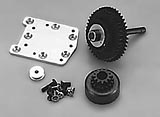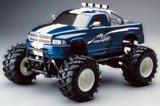
Kyosho's QRC Wild Dodge Ram
Page creation date: November 1998 Last modified 03-Dec-2011.
Gas cars don't go backwards. It's a basic rule of radio control. With the extra power and run time and noise and smoke and fun that nitromethanol glow engines give you comes the inescapable fact that you'd better not nose into an insurmountable obstacle, or someone's going to have to go and fetch your car.
Kyosho's Quick Reverse Clutch (QRC) cars thumb their noses at this maxim. They go forwards. They go backwards. They only need a plain two channel radio to do it. They've got four wheel drive and big chunky tyres, so they go over practically anything, too. And, with the optional two speed transmission (which gives two speeds in forward and two rather more frightening speeds in reverse), they go pretty darn hard. For something in the order of $600 (Australian dollars), plus radio and fuel and glow starter, all of which will set you back less than another $150.
There are two QRC cars presently available, the Baja Beetle and the newer Wild Dodge Ram, which I checked out.
The Beetle is close to identical to the Ram; except for the Beetle body, the only difference is its lower profile,
pin-spike tyres, against the Ram's larger tractor-tread rubber. The taller tyres and chunkier tread make the Ram more
prone to rollovers, and give it less traction on even surfaces, but they're much more durable than pin-spike tyres
and allow the Ram to conquer more imposing obstacles. For a car that's got "building site basher" written all over
it, these are good features.
Building it
Building an R/C car is half the fun, and there's plenty for tinkerers like me to gawk at while assembling the Ram.
The shocks are common-or-garden oil filled plastic units with spiffy aluminium caps and pre-assembled seals at the bottom of the shock bodies - there are no fiddly O-rings to install. The shock pistons and rods are one piece of steel, so if you want to change the damping you can only use different weights of oil. The blue-green oil included in the kit is perfectly acceptable.
The gear differentials are an easy build, though very tight as standard, thanks to a very close fit between the outdrive shafts and the casing, with no bearings or bushings in between. They'll wear in, but new QRC diffs will have very limited slip. This is not a bad thing, for an off-roader.
The most complex single assembly on the Ram is the QRC unit itself, but it comes pre-built. You screw it into its hole in the chassis plate, and that's that. The gears are somewhat exposed, but there's a drainage hole in the bottom of the unit, and enough airspace that any inhaled pebbles should exit without causing serious damage.
The transmission's through-the-plate mount means the QRC cars have a quite realistic powertrain layout - two dogbone driveshafts go from the central transmission to the front and rear differentials, which mount under the chassis plate. Even the steering assembly is below the plate, with a protective U-bar over the steering servo's protruding face. If having a toy that looks quite different from everyone else's turns your crank, a QRC car is for you.
Off-road gas cars are, by their nature, dirty little beasts. The oily fuel can and does get everywhere, dirt sticks to the fuel, and without assiduous after-run cleaning your toy can become a rolling agricultural experiment in no time. To keep the crud off the electronics, the QRC cars have a nifty plastic box for their radio gear, with enough room for the receiver and a standard four-AA-cell battery pack and a mounting point for a standard on-off switch on the top. The box isn't watertight, but it's not far off. If you're a raving puddle-basher, it wouldn't take more than a couple of dabs of silicone sealant to make the box completely waterproof - but both servos, especially the steering servo poking down through the chassis plate, would need to be drenched in water repellent.
The rest of the assembly is straightforward and by the numbers. Kyosho's instructions are excellent - though subtly non-scale diagrams can cause slight confusion. It's hard to make any serious mistakes, provided you occasionally read ahead to make sure the part you're holding is the part you're meant to use. The whole construction process would not be too hard for a careful beginner, and anyone with experience of constructing an electric car should have no problems building a QRC kit.
The Ram's body is held on with simple spring-clip body posts - the only steel body clip on the car is to hold the lid of the radio box shut. A rough-and-tumble car like this can be expected to shed about one body clip every minute, so the novel body holders are a great idea.
The wheels lock onto husky steel taper-fit hex-drives, instead of the flimsy pin-drive plastic hexes used by many other cars. The standard bushings - upgrading to ballrace bearings is not a bad idea, but bushings tolerate dirt better - are steel, not nylon or brass. The steering linkages are adjustable, so you can tweak toe-in or -out, although all other linkages are fixed-length.
As a matter of fact, the only feature you might expect in any gas car that the QRC lacks is a brake. That's right - there's no anchor on this boat.
On a regular gas car, no brakes is a very bad thing. But the QRC gets away with it, because of reverse. If it's
OK to stop gently, just ease back to idle and let drivetrain and tyre friction do the job. If you need to stop NOW,
slam back into reverse.
Better bits
There were a few places where I diverged from stock materials and methods when building this car.
The stock fuel tubing is the usual anaemic clear stuff; I replaced it with a couple of bucks worth of thicker, less kinkable tube.
The instructions don't tell you to use threadlock on all metal-to-metal screw connections; I did. Remember, a model gas car is, first and foremost, a device meant to shake itself to pieces. If you don't invest in a bottle of blue Loctite or equivalent (enough to build, oh, about 20 cars), bits of your car will, eventually, drop off.
The stock wheel rims don't have air holes. This is fine, if you can actually achieve a perfect seal of the tyre to the rim, but in the real world this won't happen (well, not for long, anyway - the glue will crack), and a hard landing will force air out of the tyre. If there's no way for the air to get back in reasonably quickly, you will have a clown car with triangular wheels. I drilled a teeny less-than-1mm hole though each rim on the inside of the hub disc, where it doesn't show. A hole this size won't let in much dirt or any pebbles, but ventilates the wheel just fine.
The instructions also don't say what to do with the excess antenna wire which protrudes from the antenna tube.
You should knot the wire where it comes out, to stop it retreating back down the tube, but don't chop off the excess
- this will badly affect your radio range. Instead, run the excess few inches down the side of the tube, and cover
it with a sleeve of heatshrink tubing (yours for not much from any decent electronics store), which you can shrink
with a hair dryer. This leaves no exposed wire to snag on obstacles.
Bashing it
To drive, the Ram is a bunch of fun. The compliant suspension makes it as stable as a tall truck can be - the low centre of gravity of the unconventional transmission has to help here. You can set the shock preload by means of a stepped rotating collar, but the higher settings give too much preload for the weight of the car. Remember, cranking up your shock preload does NOT make your suspension "stiffer", it just changes the car's ride height. If your ride height is already as high as it can go, increasing preload simply increases the amount of force needed to make the suspension do anything at all, and gives you a bouncier ride. If you want a harder ride, use heavier oil and/or stronger springs.
Set up on the softer preload settings, the Ram steers well on or off power. The lack of a brake encourages you to drive like a lunatic, since the only way to stop quickly is to snap the truck sideways and/or whip the transmission into reverse and try to stand the thing on its nose. Likewise, a quick transition from reverse to forward will reward you with a mighty wheelstand on any remotely grippy surface. With no centre differential, lifting the front or back wheels doesn't result in the motor unloading into the end that's in the air, so with the right combination of skill and luck you can actually hold a wheelstand for quite a while.
Doing these tricks on tarmac will see you dump the Ram on its lid fairly often, but the only damage will be to the body cosmetics - the transmission is made to shift under power, and although it likes to make a sickening "clack" as it switches direction, no great harm is done. The shock is applied via a chunky pin through a drive gear, not directly to any partially-engaged teeth, so brutal direction changes are A-OK with the QRC cars.
The included pull-start Kyosho GS-11X engine is no rip-snorting performer, but it's reliable and easy to break
in. With only one mixture adjustment screw, it's tricky to get a good compromise between idle and wide-open fuel settings,
but this is my only gripe with this otherwise perfectly adequate entry-level engine. The kit includes a good plastic-shrouded
air filter.
Get one!

The optional twin-speed transmission, with variable ratios from different spurs and clutch bells.
All in all, the QRC Ram is the perfect general purpose high fun factor off-road gas car. The reversing transmission means you won't be forever trotting over to retrieve it when it bumps into a tree, the four wheel drive and chunky tyres allow it to blast over terrain that would stop any other 1/10th scale car, and it's built like a double brick outhouse and should tolerate extreme disrespect. With the twin speed transmission and a tuned pipe, or perhaps even a hotter engine, it will also have speed enough to shame many racing trucks.
So do I want one?
No.
But that's only because I've already got Kyosho's USA-1 Nitro, the forward-only 1/8th scale firebreathing elder brother to the QRC cars. Twice the weight, more than twice the price, eight times more power.
But when the USA-1 goes nose-in against a tree, I've got to go and get it. And I just know that some time soon a kid with a QRC Ram is going to be doing dust-churning reverse burnouts around me as I trudge across the field.


![[SecureWebs]](images/sw.gif)